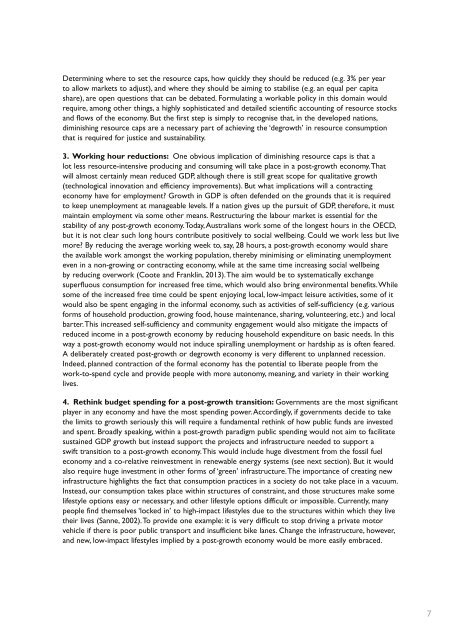peerreviewed Fellow
MSSI-IssuesPaper-6_Alexander_2016
MSSI-IssuesPaper-6_Alexander_2016
You also want an ePaper? Increase the reach of your titles
YUMPU automatically turns print PDFs into web optimized ePapers that Google loves.
Determining where to set the resource caps, how quickly they should be reduced (e.g. 3% per year<br />
to allow markets to adjust), and where they should be aiming to stabilise (e.g. an equal per capita<br />
share), are open questions that can be debated. Formulating a workable policy in this domain would<br />
require, among other things, a highly sophisticated and detailed scientific accounting of resource stocks<br />
and flows of the economy. But the first step is simply to recognise that, in the developed nations,<br />
diminishing resource caps are a necessary part of achieving the ‘degrowth’ in resource consumption<br />
that is required for justice and sustainability.<br />
3. Working hour reductions: One obvious implication of diminishing resource caps is that a<br />
lot less resource-intensive producing and consuming will take place in a post-growth economy. That<br />
will almost certainly mean reduced GDP, although there is still great scope for qualitative growth<br />
(technological innovation and efficiency improvements). But what implications will a contracting<br />
economy have for employment? Growth in GDP is often defended on the grounds that it is required<br />
to keep unemployment at manageable levels. If a nation gives up the pursuit of GDP, therefore, it must<br />
maintain employment via some other means. Restructuring the labour market is essential for the<br />
stability of any post-growth economy. Today, Australians work some of the longest hours in the OECD,<br />
but it is not clear such long hours contribute positively to social wellbeing. Could we work less but live<br />
more? By reducing the average working week to, say, 28 hours, a post-growth economy would share<br />
the available work amongst the working population, thereby minimising or eliminating unemployment<br />
even in a non-growing or contracting economy, while at the same time increasing social wellbeing<br />
by reducing overwork (Coote and Franklin, 2013). The aim would be to systematically exchange<br />
superfluous consumption for increased free time, which would also bring environmental benefits. While<br />
some of the increased free time could be spent enjoying local, low-impact leisure activities, some of it<br />
would also be spent engaging in the informal economy, such as activities of self-sufficiency (e.g. various<br />
forms of household production, growing food, house maintenance, sharing, volunteering, etc.) and local<br />
barter. This increased self-sufficiency and community engagement would also mitigate the impacts of<br />
reduced income in a post-growth economy by reducing household expenditure on basic needs. In this<br />
way a post-growth economy would not induce spiralling unemployment or hardship as is often feared.<br />
A deliberately created post-growth or degrowth economy is very different to unplanned recession.<br />
Indeed, planned contraction of the formal economy has the potential to liberate people from the<br />
work-to-spend cycle and provide people with more autonomy, meaning, and variety in their working<br />
lives.<br />
4. Rethink budget spending for a post-growth transition: Governments are the most significant<br />
player in any economy and have the most spending power. Accordingly, if governments decide to take<br />
the limits to growth seriously this will require a fundamental rethink of how public funds are invested<br />
and spent. Broadly speaking, within a post-growth paradigm public spending would not aim to facilitate<br />
sustained GDP growth but instead support the projects and infrastructure needed to support a<br />
swift transition to a post-growth economy. This would include huge divestment from the fossil fuel<br />
economy and a co-relative reinvestment in renewable energy systems (see next section). But it would<br />
also require huge investment in other forms of ‘green’ infrastructure. The importance of creating new<br />
infrastructure highlights the fact that consumption practices in a society do not take place in a vacuum.<br />
Instead, our consumption takes place within structures of constraint, and those structures make some<br />
lifestyle options easy or necessary, and other lifestyle options difficult or impossible. Currently, many<br />
people find themselves ‘locked in’ to high-impact lifestyles due to the structures within which they live<br />
their lives (Sanne, 2002). To provide one example: it is very difficult to stop driving a private motor<br />
vehicle if there is poor public transport and insufficient bike lanes. Change the infrastructure, however,<br />
and new, low-impact lifestyles implied by a post-growth economy would be more easily embraced.<br />
7


